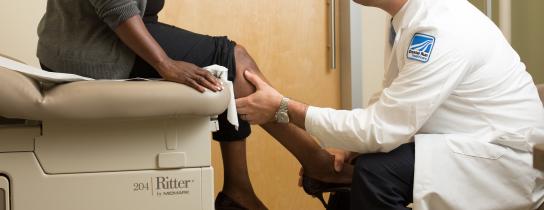
Complementary and Alternative Medicine (CAM) and Arthritis
Complementary and Alternative Medicine (CAM) and Arthritis
There’s a common adage in medicine - the more alternatives there are to treating a single problem, the less likely any given alternative is to be effective. And in this same vein, the bigger the problem is from a healthcare dollars perspective, the more treatment options tend to pop up.
Direct medical spending on arthritis and other rheumatoid conditions (AORC) in 2003 was just north of $80 billion. In New York alone, direct medical costs of AORC accounted for more than $5 billion, with another $3 million worth of lost earnings. What these numbers do not represent, however, is spending on so called “alternative” arthritis treatments. What’s that number you ask? In 2007, Americans shelled out just shy of $34 billion dollars for complementary and alternative medicine.
Complementary and alternative medicine (CAM) represents a spectrum of treatment options and approaches to disease that is not part of standard medical care. The CAM modalities that most often come to mind are acupuncture, massage, tai chi, yoga and nutritional supplements. The root problem of CAM is that its practices are not validated, in most cases, by rigorous scientific evidence.
This is not to say that CAM as a whole is without merit. Practices such as yoga and tai chi, which promote gentle range of motion and dynamic stretching, are without question beneficial to an arthritis sufferer. In fact, I think it is a disservice to lump these two validated modalities with other CAM practices, many of which are really more alternative than they are complementary.
In a series of upcoming posts, I will discuss some of the scientific evidence in favor and against various CAM modalities.
Acupuncture
The Traditional Chinese Medicine (TCM) explanation for acupuncture’s health benefits is that throughout the body run energy channels called meridians. When the flow of energy through these channels is blocked, disease occurs. The process of needling in specific locations along individual meridians releases these blockages and provides relief from the particular affliction.
The modern explanation provides that needling particular acupuncture points causes nearby nerves to send messages via the spinal cord to the brain, and to particular muscles, which can either alter our brain’s interpretation of painful stimuli, or trigger the release of hormones which modulate our pain response.
Hmmm…Interesting. So, does it work?
Here’s what NIH’s National Center for Complementary and Integrative Health has to say about that:
“Results from a number of studies suggest that acupuncture may help ease types of pain that are often chronic such as low-back pain, neck pain, and osteoarthritis/knee pain…However, clinical practice guidelines are inconsistent in recommendations about acupuncture.”
The NCCIH draws these conclusions from three cited studies:
- A 2014 Australian clinical study- acupuncture is better at relieving knee pain than no treatment, but no better than simulated or sham acupuncture
- A 2012 analysis of individual patients across multiple acupuncture studies found that acupuncture was more effective for knee pain than sham acupuncture.
- A 2010 systematic review of studies of acupuncture in hip and knee arthritis- small difference between real acupuncture and simulated acupuncture, larger difference between real acupuncture and no treatment at all.
So, why all the skepticism?
The problem with much of the research which supports acupuncture for knee osteoarthritis is that it does not compare apples to apples. Acupuncture is a procedure, and one with some degree of ceremony to it. It cannot be compared to no treatment at all. The best studies, which compare acupuncture to a sham procedure, which mimics those same ceremonial elements, but without actual needling, show very small or no differences in pain reduction.
The American Academy of Orthopaedic Surgeons (AAOS) does not endorse the use of acupuncture in the treatment of arthritis of the knee due to its lack of efficacy. One study they cite (Suarez, 2010) found that traditional Chinese acupuncture was not superior to simulated (sham) acupuncture in relieving knee pain in arthritis sufferers. What is interesting about this study is that when acupuncturists were instructed to adopt an attitude of positivity, telling their patients that they expected the treatment to provide relief, the patients had better improvement in their pain.
The Bottom Line
Acupuncture alone is unlikely to provide lasting and significant relief from knee pain due to arthritis. Seek an evaluation from an orthopedic surgeon if you believe you have arthritis of the knee.
If you are interested in learning more about acupuncture and other CAM modalities visit the National Center for Complementary and Integrative Health here.
Stay tuned for my next blog post on Yoga & Tai Chi – do these alternative medicine practices cause relief from arthritis?
Sources Cited
- Hinman RS, McCrory P, Pirotta M, et al. Acupuncture for chronic knee pain. A randomized clinical trial. JAMA. 2014;312(13):1313–1322.
- Manheimer E, Cheng K, Linde K, et al. Acupuncture for peripheral joint osteoarthritis.Cochrane Database of Systematic Reviews. 2010;(1):CD001977.
- Suarez-Almazor ME, Looney C. A randomized controlled trial of acupuncture for osteoarthritis of the knee: effects of patient-provider communication. Arthritis Care Res. 2010;62(9):1229-36.
- Vickers AJ, Cronin AM, Maschino AC, et al. Acupuncture for chronic pain: individual patient data meta-analysis. Archives of Internal Medicine. 2012;172(19):1444–1453

 Optum Radiology at Crystal Run Healthcare
Optum Radiology at Crystal Run Healthcare Request medical records online
Request medical records online